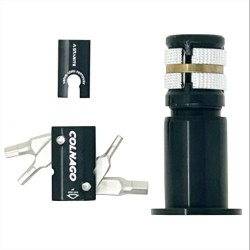Colnago


A kerékpársport történelmének része
(Ernesto Colnago és a márka részletes történetéért látogass el a Wikipedia vonatkozó oldalára ide: Ernesto Colnago & Colnago kerékpárok)
1954
– A Colnago cég története egy kis kerékpárműhelyből indult a Via Garibaldi 10-ből, az olaszországi Cambiago-ban. A vállalkozás elindításához pénzre volt szükség, ami sajnos nem nagyon volt a családnak. Az édesapja egy saját eperfáját kivágta és abból készült az első munkaasztal.
1955
– Egy kerékpározás alkalmával Ernesto találkozik Fiorenzo Magni-val, aki lábfájdalomra panaszkodik. A kerékpárt megvizsgálva észreveszi, hogy a hasjtókar nem megfelelően lett felszerelve és kijavítja a problémát. Még abban az évben a Giro d'Italia már a korábbi bajnok csapatával utazik mint szerelő, meg is szerzik a rózsaszín trikót.
1956
– A Colnagónál felmerült a villacsövek hideg hajlításának ötlete, hogy rugalmasabbak legyenek, és két, a munkaasztalra rögzített fadarabbal sikerült elérni a kívánt eredményt.
COLNAGO VÍZIÓJA
Az alapító, Ernest Colnago
Ernesto Colnago 13 évesen, hogy a milánói Gloria kerékpárgyárban hegesztőként dolgozhasson, megváltoztatta a születési dátumot az okmányokon: túl fiatal lett volna a munkához.
A kivételes szerelői, műszaki érzékét a véletlen folytán Magni fedezte fel, és ő segített neki bekerülni a Giro d'Italia csapatainak hivatalos szerelői közé.
Innentől kezdve pályája folyamatos emelkedett, amelyet nagyszerű megérzések és csodálatos alkotások hajtottak napjainkig.
A sportolóktól kapott tapasztalatok alapján, a látnok újító
 Colnago mindig is közel állt a versenyzőkhöz, meghallgatta problémáikat, törődött az igényeikkel, és végül a legáttörőbb innovációkat hozta a pelotonba.
Colnago mindig is közel állt a versenyzőkhöz, meghallgatta problémáikat, törődött az igényeikkel, és végül a legáttörőbb innovációkat hozta a pelotonba.
Eddy Merckx egyórás rekordjára egy acélkerékpárt készítettünk, amely mindössze 5750 kg-ot nyomott.
1983-ban bemutattuk a Colnago Mastert. Igazi újítás volt. A csöveknek csillag alakú profilja volt. Ez a forma még soha nem volt látható: az eredmény egy merevebb váz és a termék rendkívüli szépsége volt.
1987-től Colnago együttműködött a Ferrarival. Sok ötlet származott ebből a partnerségből. Egy meglátás különösen megmaradt: acél helyett szenet kell használni a kerékpárvázak gyártásához.
1995-ben egy Colnago karbon kerékpár nyerte meg a Paris Roubaix-t. Ettől kezdve a peloton összes kerékpárja ezt az anyagot alkalmazta.
2012-ben dobtunk piacra egy tárcsafékes versenykerékpárt. Soha senki nem csinált ilyet. Ma már széles körben elterjedtek.































